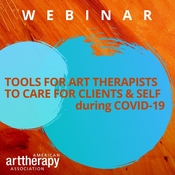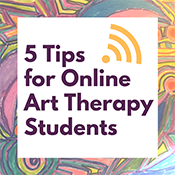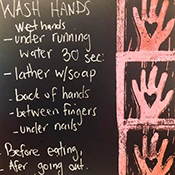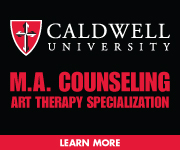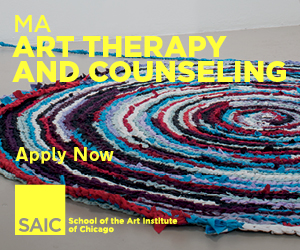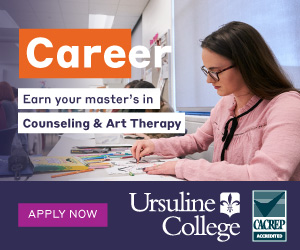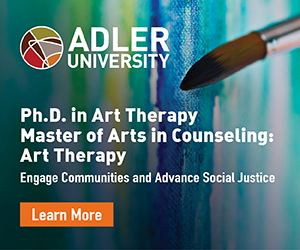 |
||||||||||||||||||||||||||||||||||
| Archive | Subscribe | Advertise | arttherapy.org | ||||||||||||||||||||||||||||||||||
Margaret Carlock-Russo, EdD, LCAT, ATR-BC, ATCS As I sit here wondering what I want to share with you about the current state of affairs in the U.S. and the world, I can’t help but think about the connectedness that has grown from this horrible situation. Like most of you, I am staying home, communicating virtually with colleagues, students, clients, family, and friends. It’s a humbling experience. Many things I took for granted are gone for now.
AATA News Even as legislatures pivot to focus most of their energy on legislation responding to the pandemic and other critical issues like state budgets, we’ve had some victories for art therapists. Licensure throughout the DMV (DC-MD-VA) region is within reach, with a new license enacted in Virginia and a licensure bill in Washington, DC passing the council!
AATA News Thank you to the more than 800 people who joined us on March 26 for our webinar, Tools for Therapists to Care for Clients and Self during COVID-19! Members can now access it for free on our online continuing education platform and earn one clock-hour credit. Our speakers covered best-practices for providing safe and hygienic materials, pivoting toward telehealth, and maintaining wellness and self-care during social distancing. For members who joined us live for the webinar and would like to collect the credit, you can take the quiz and download your certificate.
Susan Boxer Kappel, MA, ATR-BC, LCAT, CGP, Conference Chair We invite you to attend the American Art Therapy Association's 51st Annual Conference to be held in Washington, DC, October 29 to November 1, 2020. Early bird registration is now open, and we have a lot of news to share, from our keynote speaker to new flexible child care and cancellation policies, to local announcements, so read on!
Clara Keane
State legislatures have adjusted their session calendars and agenda in order to follow social distancing guidelines and to respond to the coronavirus pandemic. While the priority across the country is to protect the public and make sure other crucial legislation like state funding gets passed, most every other issue, like art therapy licensure, will have to wait for an unknown amount of time. This reality does not take away from the incredible progress we have made in our legislative efforts this year, thanks to the hundreds of art therapy advocates across the country that are paving the way for the future of the profession! Let’s take a moment to recap and celebrate the victories and the progress made this year.
Clara Keane The President signed into law the Coronavirus Aid, Relief, and Economic Security Act or the CARES Act (H.R. 748), the largest economic stimulus package in U.S. history, on March 27. This third relief package invests over $2 trillion in stimulus funds to support state governments, businesses, and individuals through this crisis.
Trica Zeyher
When I found out that my internship site, Mental Health Partners in Boulder, Colorado, was going to be transitioning to telehealth therapy from face-to-face services due to coronavirus social distancing, I felt prepared from my online graduate experiences. Edinboro University’s online art therapy program provided me with practice to succeed even in these challenging times. Here are my top five tips of how to succeed in an online art therapy master’s program.
Jordan S. Potash, PhD, ATR-BC, LCAT , LCPAT, Editor in Chief As art therapists and their clients adjust to tele-art therapy and online education, Art Therapy: Journal of the American Art Therapy Association contains several articles to help navigate these challenges. The following are a selection of recent resources on key topics. The full journal offerings, going back to volume 1, are included with AATA membership.
Gioia Chilton, PhD, ATR-BC, LCPAT, CSAC What I do matters for my community I wash my hands, for myself and others We can get through this together While socially distant, I am emotionally close
Trica Zeyher As we enter week-four of our new reality of social distancing, everything has changed. Even though my art therapy master’s program at Edinboro University is already online, I have experienced upheavals in my own life and witnessed similar chaos in the lives of my clients, educators, friends and family. Already knowing the benefits of virtual intimacy in therapy from my own online studies and experience as a client, I would like to share what I have been thinking about during this coronavirus social distancing.
Yasmin Tucker Many of my clients have been forced to apply for unemployment due to the closure of many companies in Omaha. My teens and children are coping with 8-12 weeks of school closures causing interruptions in their social-emotional learning, academic progress, school events, etc. For some of my clients, the global pandemic has increased social isolation, exacerbating their depression and anxiety symptoms. To meet the evolving needs of my clients, I have maintained a high level of communication with them via teleconferencing, email and text. For therapy sessions, I have leaned into my first language as a creative artist. I have encouraged my clients to find materials all around them to visually explore their issues.
AATA News Every year, we recognize members who are elevating the field, and we support the next generation of art therapists who will transform the profession. This is your opportunity to honor colleagues and recognize the unsung heroes and visionaries of the field or take the next step in your career by applying for a scholarship. Read below and find more information on MyAATA for opportunities in the following categories (listed by application deadline): Scholarships (May 1), Honors (June 15), Research (June 15) and Governmental Affairs (June 15). Please reach out to info@arttherapy.org with any questions.
AATA News
Our new technology means the end of separate passwords for membership, conference registration and online learning with AATA! Members have received an email with instructions to access your revamped member profile. Even if the link above has expired, you can always reset your password from the member login page. Or, if you have questions or need assistance, please contact the National Office.
Fast Company
Right now, your social media feeds may be filled with photos of banana bread, watercolor paintings, and sewing projects. These creations might not just be the result of people acting out of boredom. Creative practices can protect us from stress and anxiety, according to Girija Kaimal, an associate professor in the creative arts therapies PhD program at Drexel University and president-elect of the American Art Therapy Association.
The Philadelphia Inquirer Over the last several weeks, Mark Strandquist’s world narrowed to the distance between his home and the nearest grocery store. He felt desolation settling over his neighborhood.
“What you’re seeing is empty businesses, empty schools, empty playgrounds,” he told the Philadelphia Inquirer. “What is the emotional toll that takes?” ARTNews As the world faces unprecedented challenges due to the COVID-19 pandemic, the arts can provide some relief. Since we can’t interact with our communities physically, we in the field must think about how we can make the wellness aspects of the museum experience virtual.
ITK Social distancing can have a significant impact on people’s physical and mental health. That is what inspired art therapy student Missy Rubenfeld to make a quilt on her own — she needed something to do.
Forbes A large number of countries have imposed a formal lockdown or strongly recommend people stay at homes as much as possible. Social distancing will help slow the spread of COVID-19, but that doesn’t mean it’s always easy. Previous research on isolated groups suggests that art therapy might offer those experiencing loneliness and depression some relief.
The Columbian When we see a piece of art that moves us, we are inspired. But just appreciating art isn’t the only thing that’s good for our brains. The creative process is connected to healing, according to board-certified art therapist Jocelyn Fitzgerald. To help people see their own resilience, Fitzgerald uses art journaling.
CBC Stress can be the body’s response to an irregular situation, so feeling some amount of stress, anxiety or worry because of the COVID-19 pandemic is normal. Exercise and meditation can help alleviate such feelings, but if you're having trouble soothing those frayed nerves, creating art may be the answer. Art therapy provides a way to articulate thoughts and feelings that might otherwise be difficult to communicate.
The Ukiah Daily Journal The COVID-19 pandemic has been stressful for many. Two northern California therapists, Heather Gross and Janet Mendell, shared common concerns and offered several resources to help people cope.
Q13 Fox In a matter of weeks, the COVID-19 outbreak has changed lives around the world. As we struggle to keep up with all the changes, it can be easy to forget that we’re living in a time that will one day be a significant part of world history. An award-winning filmmaker from the Pacific Northwest is taking note and has come up with a way for parents to keep their kids busy.
|
||||||||||||||||||||||||||||||||||
|
The AATA's Art Therapy Today includes a digest of the most important news selected for the AATA from thousands of sources. Guest articles may be submitted to info@arttherapy.org. Publication of any guest article is at the sole discretion of the AATA. The opinions expressed and/or contents of guest articles, advertisements, and external links included in any AATA publication do not represent the positions or policies of the AATA. The AATA makes no warrenty or representation concerning the accuracy of such content. |
||||||||||||||||||||||||||||||||||

